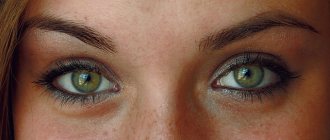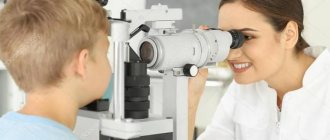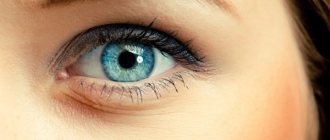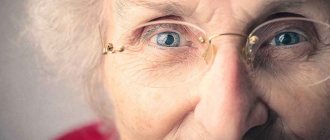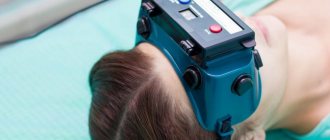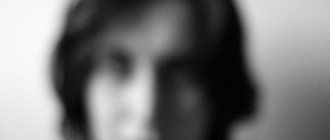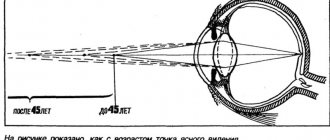, myopia in children and adults is the most common disease of the visual organs. One in four people suffers from myopia in the modern world. And the situation is getting worse every year. Experts talk about the figure “two billion”—that’s how many myopic people there were on Earth in 2010. The forecasts are disappointing - an increase is predicted - half a billion by 2020, and by 2050 - about five billion people will be myopic. Moreover, about 10% of this number have a high degree of illness.
Accessory elements of the eye
Other structures such as the eyelids, eyelashes and tear ducts are also important. Eyelashes protect our eyes from dust getting into them if we need to see what is happening around us. That is, if you are crossing the street and a wind with dust blows in your face, your eyes automatically close, your eyelashes intertwine, forming a transparent but dust-impenetrable network. The eyelids prevent larger objects from entering the eyes and also moisturize the cornea. Tear ducts work similar to a pump. They bring tears to cleanse the eye, and small particles either come out along with the tears, or go back into the tear ducts, after which they are also brought out.
Structure of the eye
The eye is an organ, part of the visual analyzer that provides vision, that is, the process of perceiving the shapes, sizes and colors of objects. And it also provides our orientation among all these objects. The visual analyzer itself includes the eye, the optic nerve, the subcortical center of the brain and the visual zone of the cerebral cortex.
Free movements of the eyeball are ensured by the external oculomotor muscles, the precise and coordinated work of which allows us to see the world around us.
The eye as an optical system
The eye is a complex optical system. The action of the cornea, lens, retina and vitreous body, which forms the eye, is similar to the action of a converging lens. The ability of the lens to change its convexity allows the eye to clearly see both distant and close objects. The retina performs the function of a screen, that is, it perceives light stimulation. The main condition for clear vision is the need for the image to be received on the retina. Farsightedness is a feature of the eye in which images of distant objects are focused behind the retina. It is corrected by wearing glasses with convex lenses. The lens of a myopic eye focuses light rays closer to the retina. Myopia is corrected by wearing glasses with concave lenses.
The most refractive structure of the eye is the cornea. A clear, reduced and upside down real image of the object appears on the retina.
The final analysis and perception of the information received by the eye occurs in our brain, in the cortex of its occipital lobes. A disruption in the condition or blood supply of any structural element of the eye can adversely affect the quality of vision.
Disturbance of normal vision
As with any part of the body, vision problems can occur due to illness, injury, or age. The following are just a few of the conditions that can affect your eyes.
- Amblyopia most often begins in childhood. One eye does not develop properly because the other, stronger eye is dominant.
- Astigmatism. The cornea or lens is not curved correctly, causing light to focus incorrectly on the retina.
- A cataract is a clouding of the lens. Leads to blurred vision and, if left untreated, blindness.
- Color blindness occurs when the cone cells are missing or not working properly. Colorblind people have difficulty distinguishing between certain colors.
- Conjunctivitis is a common infection of the conjunctiva that covers the front of the eyeball.
- Retinal detachment is a condition where the retina weakens and requires urgent treatment.
- Diplopia, or double vision, can be caused by several conditions that are often serious and should be checked by a doctor as soon as possible.
- Floaters are spots that drift across a person's field of vision. These are normal, but can also be a sign of something more serious, such as a retinal detachment.
- Glaucoma. Pressure builds up inside the eye and can damage the optic nerve, which can ultimately lead to vision loss.
- Myopia, otherwise myopia. With this disorder, it is difficult to see things that are far away.
- Farsightedness. With it, a person can clearly distinguish objects that are far away, but faces problems when the eye cannot focus on nearby objects.
- Optic neuritis.
- Strabismus. The eyes point in different directions; this is especially common among children.
In this article we will take a closer look at myopia (myopia).
Signs of the disease
The name “myopia” speaks about the nature of the disease. “Near the hands”, i.e. near - I see well, in the distance - poorly, blurry. The beam of light is formed in front of the retina, while the norm is on the retina.
Examination of preschoolers is usually carried out using a table that depicts objects known to children. For those who can read, use Sivtsev’s table.
As a rule, myopia of both eyes in children and adults .
SIGNS OF THE DISEASE:
- The baby brings the objects in question, books close to his face;
- When watching TV or doing computer work, the child tries to position himself closer to the screen;
- after hard work with small objects or reading, the eyes become very tired and headaches occur;
- The baby squints to see something in the distance, blinks frequently, and rubs his eyes.
is most often diagnosed age children , from eight to ten years old. By the age of 14-16, its degree may increase. In the 21st century, another age has been added when myopia progresses - 23 years. The reason is the increasing load on the visual system, the period of active work.
Vision indications
From childhood, when we visited an ophthalmologist, we were taught a percentage scale indicating the acuity of the visual sight:
- 100% - excellent,
- 90-75% - good,
- 74-60% - satisfactory,
- less than 60% is bad.
This interpretation is more understandable to patients, but does not provide specific information for specialists. Today, a different, additional scale has been developed, indicating the power of diopters, which should correct a certain acuity.
Conventionally, indicators of ophthalmological health can be divided into several categories:
- 1 - excellent;
- 1.5-2 - good;
- 2-4 satisfactory;
- 4-7 - bad;
- more than 7 - very bad.
The presented scale can be adjusted depending on the specifics of the disease. If you make an appointment with an ophthalmologist, they will tell you which field is more suitable for you - “+” or “-”, and, accordingly, will prescribe the correct treatment. Today we will talk about what to do if vision is minus 8. Is this dangerous to health, does it need to be treated and what needs to be done? If your personal medical card says “Vision 8,” what should you do? In simpler and more understandable language, the patient does not see what is happening 10 meters away, but is clearly aware of what is happening directly at arm's length. Looking at the above categories, we can say with confidence that the patient has very serious problems and it is simply impossible to do without surgical intervention, long-term drug treatment and constant inpatient support.
Degrees of myopia
There are the following degrees of myopia in children :
- weak, up to minus 3 diopters;
- average, from minus 3 to 6 diopters;
- strong, over minus 6 diopters.
Low myopia in children is the most common in all countries. This degree is typical for most schoolchildren. In this situation, there is no need to constantly wear glasses and contacts. They can be worn when you need to see objects in the distance - at school, institute during lessons, when visiting the theater, etc.
Moderate myopia in a child means significant changes in the fundus of the eye, disturbances in the blind spot area, and thinning of blood vessels. Parents cannot always understand how their children or schoolchildren see them. To explain simply, the orientation in space is disturbed, namely:
- objects and people in the distance are difficult to distinguish;
- the text in the book is not visible at arm's length;
- it is difficult to distinguish the vehicle number, etc.
In this case, correction with lenses or glasses is necessary. Schoolchildren and teenagers are often embarrassed to wear glasses. Parents should help in this case - choose stylish frames or purchase lenses. With myopia of five to six diopters, without vision correction, life may be in danger - you may not see an approaching car, uneven roads, etc.
A high degree of myopia in a child is a dangerous condition. Significant changes in the organs of vision occur: the retina and fundus vessels are severely worn out. A person sees approximately 1 to 10% of 100%. The closest point of vision is located at a distance of five to ten centimeters. This myopia contributes to the occurrence of other diseases.
Diagnosis of myopia
Let's look at the situation if vision is 8: what does this diagnosis mean? Let's start with the fact that 8 (+8) indicates the presence of obvious symptoms of myopia. The causes of the disease can be very diverse: head injuries, disturbances in the functioning of the heart, disruptions of the endocrine system, genetic predisposition, work with intense concentration of vision on small text, details, constant exposure to radiation from gadget screens, etc. Since 8 diopters is the amount , which falls into the third category of myopia (high myopia), then treating the disease with conventional methods is useless.
Negative development of the disease
If vision deteriorates by one or more diopters per year, then children are diagnosed with progressive myopia .
Its occurrence has reasons:
- hereditary factor;
- significant loads on the optical system;
- weakness of accommodation - the ciliary muscle is poorly developed or impaired from birth, or its work has been negatively affected (illness, injury);
- The eye sclera is weakened due to intraocular pressure.
Vision 8: How does a person see?
With such vision, human activity is sharply limited. If you do not use glasses and contacts, you may experience great discomfort in everyday life.
On the street, people with such vision find it difficult to distinguish people's faces; they may not even recognize their relatives. Road signs are indistinguishable, which can be life-threatening. Inscriptions, any signs, house numbers, street names - everything that contains alphabetic and numeric characters are, in principle, indistinguishable for such poor vision. They become stratified, overlap each other, and a person not only cannot read, but for him the text is a blurred, continuous, homogeneous spot. It is known that in good daylight we see much better than in twilight.
How does a person see with vision minus 8 at night? No matter how it sounds, without aids that increase visual acuity, it is better not to go outside at all. Even large objects may not be noticed, since without lighting their contours merge together. Such a person can crash into another pedestrian, fail to notice a cyclist, trip over something on the ground, etc. With all this, his posture also worsens. This is especially common among schoolchildren and students, as well as among people whose work involves writing. After all, if you don’t wear glasses or contacts to better see what you write or read, you constantly bend over, slouch, and all this becomes chronic.
So, if vision is minus 8, how does a person see, what to do and how to deal with it?
What are the forms of eye refraction?
Ophthalmologists distinguish six forms of eye refraction:
- Emmetropia (normal eye refraction). A person sees clearly at all distances: near, medium and far.
- Myopia (nearsightedness). People with myopia have clear near vision, but distant vision is unclear and blurry.
- Hypermetropia (farsightedness). With farsightedness, the opposite situation of myopia develops - a person sees in the distance worse than near.
- Presbyopia (age-related farsightedness). This refractive error occurs in people over 45 years of age and is associated with loss of elasticity of the lens and weakening of the accommodative function of the eye.
- Anisometropia. In this case, the eyes have different refraction, for example, the right eye may suffer from myopia, and the left eye may suffer from hypermetropia.
- Astigmatism. In this case, vision deteriorates at all distances.
Returning to the question raised at the beginning of the article about visual acuity above normal, it should be said that such cases are quite rare, but nevertheless they are considered the norm. In this case, a person’s qualitative indicator of eye vigilance is not equal to one, but, for example, 1.5 or even 2.0. This unique feature of the visual apparatus is due to the fact that the retinal elements responsible for high vision are located next to each other. It is laid down genetically. Such people are a little luckier than others - after all, they really have “eagle vision.” But, nevertheless, this does not mean that they should not take care of eye health - they are recommended to undergo preventive examinations by an ophthalmologist with the same frequency as all other patients, i.e. at least once a year.
MagazinLinz.ru team
Treatment method for 3rd degree myopia
In no case should the 3rd degree of myopia be dealt with in the same way as the first. Some unscrupulous ophthalmologists say that the nature of the disease is the same and it is only appropriate to increase the intensity of restorative measures. But that's not true. In such cases, it is suggested to resort to laser surgery.
The patient's eyelids are secured so that during the operation they do not block access to the main structures, and a local anesthetic is dripped into the eyes. After which the robot uses a special tool (since extreme precision is required here) to cut the cornea. The attending physician uses a special needle to move the cornea away, but does not tear it off, and dries the liquid that remains under the cornea. All these manipulations are performed so that the laser beam acts directly on the lens, changing its curvature. When all actions with the laser are completed, a special physiological solution is again poured into the place under the cornea, and the cornea returns to its place.
During the entire operation the patient is conscious, this is very important. After all this, a course of rehabilitation is required, which includes restrictions on reading time, lack of physical activity, excessive mental work, and more. This period can last from several days to a week. As a result, the person returns to normal (100%) or zero vision.
On the other hand, laser correction is contraindicated for a huge number of people, because this type of operation has a huge impact on the entire body, especially on the cardiovascular system. It is also not prescribed to children under 18 years of age, women who have never given birth, or pregnant women. Then your doctor may recommend another type of surgery that will be equally effective. No matter how strange it may sound, eye gymnastics and a special restorative massage can be your lifesaver in resolving this issue. Gymnastics can be done either with a specialist or simply at home. Undoubtedly, this method of getting rid of the disease will take longer and requires constant systematic effort, but the severity will increase within a few weeks.
Vision minus 7 - what does it mean, how does a person see, how to restore vision - About the eyes
Visual acuity is indicated in diopters; depending on this parameter, the ophthalmologist determines the degree of deviation from the norm and prescribes an appropriate treatment method. The “minus 1” indicator not only indicates visual impairment, but also indicates an ophthalmological disease called myopia.
The diagnosis of “vision minus 1” is the initial stage of myopia. A young man with such vision is fit for military service. Treatment is done without glasses or lenses. The main thing in solving this problem is to prevent the pathology from getting worse.
- 1. What does vision minus 1 mean? 1.1. Symptoms
- 1.2. Causes
- 2.1. Operations
What does vision minus 1 mean?
This diagnosis indicates mild myopia. The presence of an ophthalmological disease can be determined by the accompanying signs:
- blur of distant objects,
- visibility of nearby objects is at the same level.
According to Sivtsev’s table, vision minus 1 means that the patient sees the first lines well (usually from 1 to 3), and his visual acuity is 0.1. We can talk about the initial stage of myopia if a person’s vision is within -3 diopters.
Sivtsev table
Diagnosis (visual acuity in diopters) and its designation:
| Index | Degree of myopia |
| Minus 0.75 | Minor deviation from the norm |
| Minus 1.25 | Low myopia |
| Minus 1.5 | |
| Minus 4 | Moderate myopia |
| Minus 7 | High myopia |
The following indicators are associated with army fitness categories:
| Suitability categories | Myopia or farsightedness, diopters | Designation |
| B-3 | 3,0-6,0 | Good with minor restrictions |
| IN | 6,0-12,0 | Limited use |
| D | from 12.0 | Unfit |
Symptoms
A nearsighted person has an enlarged eyeball. He also has problems shifting his gaze between distant and nearby objects. Other symptoms:
- objects begin to “double”,
- visual perception of colors is impaired,
- "floaters" appear before the eyes,
- photosensitivity increases.
The above symptoms indicate worsening myopia. Accelerated degradation of the eye muscles indicates a decrease in vision at the level of 1 diopter per year.
Causes
Myopia begins to manifest itself both in childhood and in adulthood. A child may begin to develop myopia at the age of 3-5, when he goes to school (at 7 years old) or is in the 5th grade.
Among the causes of pathology are:
- accommodative - the disease appears due to weakness of the eye muscle,
- anatomical - due to the fact that the organ of vision grows in the anteroposterior region, the ability of normal focusing decreases.
Factors influencing the development of myopia in children include:
- genetic predisposition,
- stress,
- poor quality food,
- weakening of the sclera
- decreased immunity,
- prolonged interaction with electronic devices,
- failure to comply with personal hygiene rules,
- bad environment.
In adults after 25 years of age, myopia develops for a number of reasons:
- head injuries,
- overwork,
- continuous work related to the computer or looking at small parts,
- Unhealthy Lifestyle,
- heredity.
Treatment
You can eliminate the symptoms of myopia, or myopia, with the help of:
- wearing glasses and contacts,
- operations,
- medicines,
- exercises.
Wearing contact lenses or glasses will correct visual inaccuracies. But this method for visual impairment minus 1 is controversial. Its effectiveness depends on the cause of the pathology. If myopia occurs due to muscle weakness, then wearing glasses and contacts will aggravate the situation.
Operations
This type of treatment is only available to patients over 18 years of age.
The following types of surgical intervention are distinguished:
- scleroplasty (strengthening the posterior wall of the lens),
- laser correction (changing the shape of the cornea),
- surgery to replace the lens with an artificial lens.
Laser correction is not possible for myopia of more than 15 diopters. The type of surgical intervention is prescribed by an ophthalmologist.
Medicines
Visual impairment can be restored if special medications are used. Prescribed drugs include:
- 1. Anti-inflammatory: diclofenac, dexamethasone.
- 2. Antibacterial: Albucid, Floxal.
- 3. Vitamins: Quinax, Taufon.
- 4. Moisturizing: Oftagel, Systane.
- 5. Adrenergic blockers: Fotil, Proxofelin.
- 6. Vasoconstrictors: Visine, Okumetil.
- 7. Antiallergic: Allergodil, hydrocortisone.
The dosage and frequency of use are indicated by the ophthalmologist.
Eye exercises
There are many sets of exercises for myopia. The image shows one of them. Each exercise should be performed at least 6 times for each eye.
A popular technique for restoring vision is the Bates complex. The doctor believed that it was necessary to train the external muscles of the eyeball. One of the main exercises in his method for restoring vision is palming.
Before performing or applying the described treatment methods, you should consult an ophthalmologist.
Source:
How do people with myopia see the world around them? — encyclopedia Ochkov.net
Visual impairment leads to image distortion. In the case of myopia, objects located at a distance appear blurry, and those that are closer appear clearer.
For those who have never experienced vision problems, it is difficult to imagine how a person with myopia sees. People with this disorder report having difficulty distinguishing objects at a distance. The cause of this problem is a change in the shape of the eye lens. Let's take a closer look at the symptoms, methods of treatment and prevention of this disease.
Causes of myopia
Thanks to the development of science, today this visual impairment is well studied. In ophthalmology, the disease is called myopia.
At the physiological level, the pathology is associated with a defect in the shape of the eye lens. Under the influence of a number of factors, it changes and becomes more elongated. As a result, the optical axis of the eye increases, as a result, the refraction of light rays occurs at the wrong angle. The image is ultimately formed not on the retina, as with healthy vision, but in front of it.
Myopia happens:
- congenital;
- acquired.
In the first case, the disease is detected in a child in the first year of life. Experts believe the cause of its appearance is a genetic predisposition. If mom or dad had vision problems, then with a probability of up to 50% they will be passed on to the child. If the disorder was diagnosed in both parents, then with a risk of up to 75% the disease will be passed on to the baby.
In addition, the cause of congenital myopia during pregnancy can be:
- disorders during intrauterine development;
- bad habits;
- poor nutrition;
- infectious diseases;
- fetal hypoxia;
- premature or difficult birth.
Factors contributing to the development of myopia during life are:
- prolonged eye strain;
- violation of work and rest schedules;
- poor lighting when working with small parts or reading for a long time;
- long periods of work at the computer without a break.
Very often, myopia appears in schoolchildren when visual stress increases. During this period, it is very important to pay attention to the problem, since without proper treatment the disease will progress.
Imaginary myopia
Deterioration of vision is not always associated with physiological changes in the lens of the eye. Decreased visual acuity sometimes occurs due to imaginary myopia. During prolonged eye strain, a spasm of accommodation occurs. This phenomenon is called imaginary or false myopia.
Imaginary myopia is a malfunction of the eye (ciliary or ciliary) muscle. This part of the eyeball is responsible for focusing. When viewing objects at a distance, the ciliary muscle relaxes, but when viewed close, on the contrary, it becomes tense.
It changes the shape of the lens, allowing us to see equally well near and far. When a spasm occurs, the muscle stops relaxing and is in constant tension.
As a result, a person develops all the same symptoms as with myopia, that is, he sees well up close, but at a distance the contours of objects become blurred.
This violation is caused by:
- increased visual stress;
- osteochondrosis of the cervical spine;
- constant work at the computer, frequent use of gadgets and watching TV.
Spasm of accommodation occurs in children and adults. As a rule, schoolchildren and students who have to study a lot encounter this phenomenon. In adults, the disorder is often caused by prolonged, uninterrupted work at the computer.
Spasm of accommodation is not an ophthalmological disease, however, it is necessary to take measures to eliminate it, since in the future it can lead to vision problems. There are three ways to get rid of false myopia:
- eye drops (usually prescribed “Atropine”, “Tropicamide”, “Mydriacyl”, “Cyclomed”);
- physiotherapy (carried out in a medical institution);
- gymnastics for the eyes.
Only a specialist can determine whether a person’s myopia is false or true. Therefore, at the first signs of myopia, you should visit an ophthalmologist.
Symptoms of myopia
A person with myopia without clear outlines sees the world around him. Therefore, the main symptom of the disease is blurring of the contours of objects located at a distance.
In addition, myopia may be accompanied by the following symptoms:
- rapid eye fatigue;
- headache;
- fear of light;
- burning and pain in the eyes.
How do people with varying degrees of myopia see?
Disturbances that occur in the organs of vision during myopia cause changes in the eyeball, or rather its enlargement. The more the size of the eyeball increases, the more vision decreases.
Myopia causes eye enlargement from 1 to 7 millimeters or more. Every one millimeter deviation from the norm causes vision deterioration by three diopters.
There are three degrees of myopia:
- first (or weak) - vision is reduced to -3 diopters;
- second (or average) - vision is reduced from -3.25 to -6 diopters;
- third (high or strong) - vision is reduced by more than -6.25 diopters.
How do people with myopia see? When vision is slightly reduced, that is, the first degree of the disease is diagnosed, a person sees 90%. In everyday life this manifests itself as minor discomfort.
For example, it is difficult to see the number of a house on the opposite side of the street or read a sign on a store from a distance. At the same time, no difficulties arise when viewing objects close up or reading.
Sometimes the picture on a TV may become blurry if it is located at a considerable distance. For example, by the way a child sees notes on the board, you can understand whether he has vision problems. In this case, you can do without glasses.
However, if a certain action requires special concentration, it is still better to use correction means. So, you should wear glasses while driving a car.
It should be noted that even with a low degree of myopia, you cannot select glasses yourself. Incorrectly selected optical aids can aggravate the problem. In addition, you may experience a headache or painful sensations in the eyes.
As you might guess, with each subsequent degree of myopia a person sees worse and worse. With moderate myopia, people have to squint to see objects in the distance. Already at a distance of several meters, things take on blurry outlines.
In such a situation on the street, it is difficult to distinguish faces, they seem blurry, and features cannot be discerned. To understand how people with myopia see the world, imagine a blurry photo. At a distance of 20-30 centimeters, people with myopia still see well.
When high myopia occurs, people see objects only at arm's length. Vision is only 1-2%. A person sees the text only if they hold a piece of paper close to their face.
In general, myopia is characterized by poor distance vision, but people with myopia can see objects well at close distances.
How a person with visual impairment sees objects is checked in the ophthalmologist’s office using special tables. The most famous of them is the Sivtsev table. Many people have been familiar with the test using it since childhood.
It consists of 12 lines. From top to bottom, the font size decreases.
Depending on whether a person sees all the letters or with errors, the acuity of his vision is determined.
Treatment of myopia
After a diagnosis of myopia is made, the patient is prescribed glasses or contact lenses. Optical products will help you see better in everyday life. But they do not solve the problem of poor vision. Correcting myopia requires medical intervention. There are currently three main treatment options:
- medicinal;
- physiotherapy;
- surgical.
Drugs intended for the treatment of myopia improve blood circulation in the organs of vision, relax the ciliary muscle, and promote metabolic processes. They are available in both drops and tablets.
Source: https://4hospital.ru/lechenie/zrenie-minus-7-chto-eto-znachit-kak-vidit-chelovek-kak-vosstavit-zrenie.html
Glasses for vision 8
Glasses can be prescribed even at minus 1. Then which of them are prescribed for poorer vision? Glasses vary in thickness. The worse your vision, the thicker the lens should be.
Good choices for eyeglass lenses for nearsightedness include high index lenses with anti-reflective coating. Additionally, consider photochromic lenses to protect your eyes from ultraviolet and high-energy blue light and reduce the need for a separate pair of sunglasses when outdoors. If you are nearsighted, the first number (“sphere”) on your glasses or contact lens prescription will be preceded by a minus sign (–). The higher the number, the more nearsighted you are.
Lenses must be made to order after the doctor writes a prescription. Under no circumstances should you thoughtlessly take or wear glasses that are not suitable for you. As a result of improper wearing, vision will not only not improve, but may also drop significantly lower. There may also be frequent headaches, loss of energy and a general decrease in mental capacity. Poor vision in an 8-year-old child may need treatment. To prevent a decrease in eye sharpness, it is recommended to spend more time in the fresh air and keep yourself and your children busy with active games.
Such tricks, especially in the modern world, where a person practically does not move his eyes due to working and playing on a computer, smartphone, etc., will help keep the eye muscles in good shape and prevent visual acuity from dropping from 0 to 8. If your child has 8 years old with poor vision, then immediately consult a doctor, and he will prescribe the correct treatment, if possible, because in childhood you can correct an unwanted disorder faster and more effectively, so that by adulthood the person will be healthy.
Treatment
Myopia is practically not amenable to conservative treatment. Medicines, eye exercises, physiotherapeutic methods, exercise equipment support the visual organs, preventing the disease from progressing. It is necessary to create good conditions for the younger generation - monitor compliance with the daily routine, ensure a balanced diet. You need well-chosen physical activity and walks. All this will help stop the progression of the disease.
With moderate myopia, you can get rid of the disease surgically. But the operation is possible at the age of 18 to 45 years. Schoolchildren and teenagers can have their vision corrected using a convenient and discreet means – lenses.
Myopia or myopia is recognized as the most common ophthalmological disease on the globe. 1 in 4 children suffers from this eye disease.
You can meet people of different ages wearing negative glasses or lenses. Men and women, children, and elderly people all over the world are diagnosed with myopia.
There are more and more myopic people every year. Statistics show that in 2010 there were about two billion people. According to forecasts, by 2021 another half billion will be added to them. And by 2050, 5 billion people, approximately half of the world's population, will have poor vision. Moreover, myopia in 10% will be very high, associated with the risk of complete blindness.
The problem of myopic people is especially acute in Singapore, China, and South Korea, where 50% of primary school students wear glasses. This is because Asian countries place great emphasis on studying hard. In England this figure is much lower – 10%.

